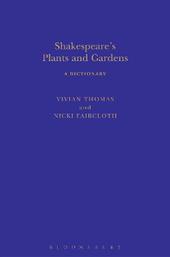
|
Shakespeare's Plants and Gardens: A Dictionary
Hardback
Main Details
| Title |
Shakespeare's Plants and Gardens: A Dictionary
|
| Authors and Contributors |
By (author) Vivian Thomas
|
|
By (author) Nicki Faircloth
|
| Series | Arden Shakespeare Dictionaries |
|---|
| Physical Properties |
| Format:Hardback | | Pages:432 | | Dimensions(mm): Height 234,Width 156 |
|
| ISBN/Barcode |
9781441143709
|
| Classifications | Dewey:822.33 |
|---|
| Audience | | Undergraduate | | Postgraduate, Research & Scholarly | |
|---|
|
Publishing Details |
| Publisher |
Bloomsbury Publishing PLC
|
| Imprint |
The Arden Shakespeare
|
| Publication Date |
27 February 2014 |
| Publication Country |
United Kingdom
|
Description
Shakespeare lived when knowledge of plants and their uses was a given, but also at a time of unique interest in plants and gardens.His lifetime saw the beginning of scientific interest in plants, the first large-scale plant introductions from outside the country since Roman times, and the beginning of gardening as a leisure activity. Shakespeare's works show that he engaged with this new world to illuminate so many facets of his plays and poems. This dictionary offers a complete companion to Shakespeare's references to landscape, plants and gardens, including both formal and rural settings.It covers plants and flowers, gardening terms, and the activities that Shakespeare included within both cultivated and uncultivated landscapes as well as encompassing garden imagery in relation to politics, the state and personal lives. Each alphabetical entry offers an definition and overview of the term discussed in its historical context, followed by a guided tour of its use in Shakespeare's works and finally an extensive bibliography, including primary and secondary sources, books and articles.
Author Biography
Nicki Faircloth is a freelance lecturer and writer based in London Vivian Thomas is a freelance lecturer for the University of Warwick and the Shaksepeare Birthplace Trust
ReviewsScholars looking for the symbolic significance of unfamiliar plants will find much of use here, as demonstrated by the entry on the medlar, a now uncommon fruit with both sexual connotations and punning potential. The volume is almost as interesting for its wide-ranging introduction and survey of botanically related criticism as for the entries...It will be a good addition for comprehensive Shakespeare collections or libraries supporting intensive study of the early modern period. Summing Up: Recommended. Comprehensive early modern collections supporting graduate students and researchers/faculty. -- S. Magedanz, California State University San Bernardino * CHOICE * This latest work in the Arden Shakespeare Dictionaries series offers a fascinating and comprehensive resource for students and the interested general reader, in both Shakespearean studies and in garden history, seeking as it does to examine every plant and aspect of gardens in Shakespeare's work... An impressive work of scholarship and research, it largely succeeds in this challenging goal. -- Jane Whitaker, University of Brighton, UK * Around The Globe * Thomas and Faircloth's value-added concordance brings a contemporary academic treatment to William Shakespeare's use of plant and garden terminology. The terms in the roughly 350 entries appear in the forms in which Shakespeare used them and are alphabetically arranged. Most words are discussed in a minimum of a half-page, with those heavily used in the Bard's works-lily, garden, forest-explored over multiple pages. Entries place the word/item in its historical, social, and literary context; identify its placement within Shakespeare's writings; explicate his use of the word; and quote the associated line(s). The volume has an intriguing appendix in which each of the playwright's works is listed alphabetically by title, beneath which is a collective of all the plant and garden-based words used within it. VERDICT:Very useful for those libraries supporting Shakespearean scholars and those collecting the other titles in the series. -- Luca Sanborn * Library Journal * This substantial book allows those interested in William Shakespeare's uses of plant names, gardening terms and horticultural allusions to explore the facts, hypotheses and myths ... Undoubtedly an authoritative work of considerable effort and scholarship that should be consulted by everyone concerned with interpreting Shakespeare's texts. -- E. Charles Nelson * Archives of Natural History *
|